February 9, 1927
Los Angeles
 Sure, while we’ve repeatedly reported to you about blindfolded drivings—today was announced something that actually guarantees splintering wood and crunching metal.
Sure, while we’ve repeatedly reported to you about blindfolded drivings—today was announced something that actually guarantees splintering wood and crunching metal.
Finley Henderson has a really good idea: dive an airplane from a height of 1,000 feet, clip the wings from the machine between two telegraph poles, and crash into a bungalow with the remains of his plane at sixty miles an hour.
Don’t worry: he wears the shoulder and shin guards of the football field, the breast pad of the baseball umpire and a catcher’s mask. Kids, try this at home. Above your home. Into your home.
Sponsored by Earl L. White and KELW! Come on out to Burbank’s Magnolia Park and watch the fun!
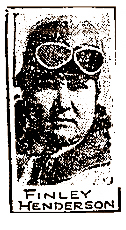 For the record, when the stunt was performed on February 20, Finley emerged unscathed, smoking a cigarette. And then noted for the wowed crowd and boys of the press “The stunt is easy if you know how to do it.”
For the record, when the stunt was performed on February 20, Finley emerged unscathed, smoking a cigarette. And then noted for the wowed crowd and boys of the press “The stunt is easy if you know how to do it.”
Finley made the news again in June, when, at the Glendale Airport Air Rodeo, just as he was stepping into his plane (this time, to crash into a barn), in front of all those eager spectators, United States Deputy Marshal Charles F. “Spoil Sport” Walsh served Finley a summons. Hot on Walsh’s heels were pansy Capts. Walter F. Parkin and William B. Breingan, of the recently created Aeronautics Branch, United States Department of Commerce (oh, Mary), there to enforce their writ of injunction restraining Finley from performing the stunt.
Apparently, these hi-falutin’ aeronautics fellows have just made stunting within five miles of a regularly established and operated air line against the law…apparently also is flying a plane that is wholly unsafe, and is likely to collapse upon the audience when in flight.
But wasn’t that part of the thrill? No wonder we went into a depression.


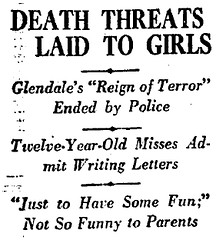 Three Glendale families found interesting missives in their mailboxes this week, and they weren’t no holiday wishes.
Three Glendale families found interesting missives in their mailboxes this week, and they weren’t no holiday wishes.
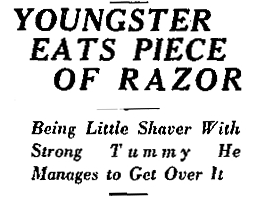

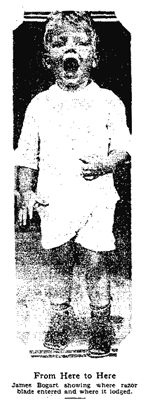 October 13, 1927
October 13, 1927


 Today, Dr. A.F. Wagner, county autopsy surgeon announced that a quantity of arsenic had been found in Carson’s viscera. An inquest was ordered, with Mrs. Carson and J.E. Walker, Carson’s business partner appearing as key witnesses. And of course, the Times gave the whole thing a clever name, just in case the story had legs.
Today, Dr. A.F. Wagner, county autopsy surgeon announced that a quantity of arsenic had been found in Carson’s viscera. An inquest was ordered, with Mrs. Carson and J.E. Walker, Carson’s business partner appearing as key witnesses. And of course, the Times gave the whole thing a clever name, just in case the story had legs.


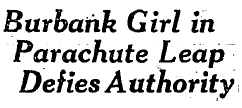 And back in the fair city of Burbank, 17-year-old Mignon Jones parachuted from a height of 2000 feet clad only in a sailor suit. Jones’s mother had discovered her daughter’s plan, and notified the police in the hopes of stopping her. However, by the time Burbank police officers arrived at the airport, Jones had already made a perfect landing and vacated the premises. She was later found at a local skating rink.
And back in the fair city of Burbank, 17-year-old Mignon Jones parachuted from a height of 2000 feet clad only in a sailor suit. Jones’s mother had discovered her daughter’s plan, and notified the police in the hopes of stopping her. However, by the time Burbank police officers arrived at the airport, Jones had already made a perfect landing and vacated the premises. She was later found at a local skating rink.
 adies of Los Angeles! Do your cakes fall? Is your husband weary of tough pot roast? Do the words, "Company’s coming" fill you with dread? Never fear, because Mabelle E. Wyman is here!
adies of Los Angeles! Do your cakes fall? Is your husband weary of tough pot roast? Do the words, "Company’s coming" fill you with dread? Never fear, because Mabelle E. Wyman is here!
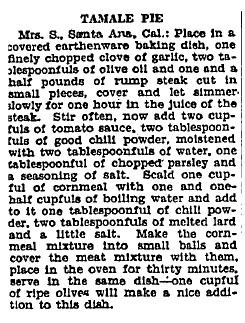 After the first class, Wyman encouraged her audience to submit questions to a question box, and guaranteed answers either during the next class or in her "Practical Recipes" column. While most columns simply answered requests for particular recipes, others were more cryptic. One can only wonder at the query that prompted Wyman to write, "Mrs. S., Los Angeles: I am sorry but the law prohibits my either printing the recipe you ask for or sending it through the mail." Bathtub julep, anyone?
After the first class, Wyman encouraged her audience to submit questions to a question box, and guaranteed answers either during the next class or in her "Practical Recipes" column. While most columns simply answered requests for particular recipes, others were more cryptic. One can only wonder at the query that prompted Wyman to write, "Mrs. S., Los Angeles: I am sorry but the law prohibits my either printing the recipe you ask for or sending it through the mail." Bathtub julep, anyone? 